Did you know that Samoa, a tropical paradise in the heart of the South Pacific, is home to a remarkable array of plant and animal species? With its rich biodiversity and delicate ecosystems, this small archipelago is teeming with natural wonders waiting to be explored.
Samoa’s ecosystem is a tapestry of natural habitats, supporting over 500 species of native flowering plants, 220 species of ferns, and a diverse range of fauna. From mammals and birds to reptiles and fish, the biodiversity in Samoa is awe-inspiring.
However, this fragile balance is under threat. Deforestation, population growth, overexploitation of resources, climate change, and invasive species pose significant challenges to Samoa’s biodiversity. Efforts in conservation and sustainable development are crucial to safeguard these valuable ecosystems and support the well-being of both humans and nature.
Key Takeaways:
- Samoa is rich in biodiversity, with over 500 species of native flowering plants and 220 species of ferns.
- The country is home to diverse fauna, including mammals, birds, reptiles, insects, land snails, and fish.
- Marine biodiversity in Samoa is characterized by vibrant coral reefs and a wide range of fish species.
- Threats to Samoa’s biodiversity include deforestation, overexploitation of resources, climate change, and invasive species.
- Conservation efforts and sustainable development practices are essential for protecting Samoa’s unique ecosystems and cultural heritage.
Flora Diversity in Samoa
Samoa’s flora is a magnificent display of biodiversity, with a rich variety of plant species that contribute to the vibrant ecosystem. The archipelago is home to 500 species of native flowering plants and 220 species of ferns, showcasing the immense flora diversity found in Samoa.
Approximately 25% of the native plant species in Samoa are endemic, meaning they are found exclusively in this region. These endemic plant species play a crucial role in maintaining the unique biodiversity of Samoa and are a testament to the country’s conservation efforts.
The vegetation in Samoa can be classified into five distinct plant communities, each with its own set of plant species adapted to the diverse climate and terrain. These plant communities provide essential habitats and resources for various flora and fauna, making them vital components of Samoa’s ecosystem.
The native flowering plants in Samoa add vibrant colors to the landscape, creating a visual feast for visitors and locals alike. They also play a crucial role in supporting local ecosystems by providing nectar, pollen, and food sources for insects, birds, and other wildlife.
Samoa is also known for its remarkable fern species, which enhance the beauty of the forests and wetland areas. These ferns contribute to the lush greenery and add a touch of elegance to the natural surroundings.
Overall, the flora diversity in Samoa is a sight to behold, highlighting the country’s commitment to preserving its natural heritage and ecosystem.
https://www.youtube.com/watch?v=PO2ZDXzg2oE
Unique Plant Species in Samoa
In addition to its overall flora diversity, Samoa is home to several unique plant species that are found nowhere else in the world. These endemic plants are a testament to the country’s distinct ecological characteristics and further underline the importance of conservation efforts in preserving Samoa’s biodiversity.
“The endemic plant species in Samoa are not only fascinating in terms of their individual characteristics, but they also play a crucial role in maintaining the delicate balance of the ecosystem. Protecting these unique plants is essential for the long-term sustainability of Samoa’s flora diversity.”
Samoa’s endemic plant species are a source of pride and serve as a reminder of the country’s rich natural heritage. They provide valuable insights into the evolutionary history of Samoa and offer potential scientific discoveries for researchers and botanists.
Conservation of Flora Diversity
Recognizing the significance of its flora diversity, Samoa has implemented various conservation measures to protect its valuable plant species and habitats. These efforts include the establishment of protected areas, the promotion of sustainable agriculture practices, and collaboration with local communities.
- Samoan Government initiatives focus on preserving critical habitats and creating botanical reserves to safeguard native plant species and their ecosystems.
- Conservation organizations in Samoa work closely with local communities to raise awareness and implement sustainable practices that ensure the long-term survival of endemic plant species.
- Research and monitoring programs help identify and protect threatened plant species, allowing for targeted conservation efforts.
“Sustaining Samoa’s flora diversity requires a multi-faceted approach that involves the active participation of the government, conservation organizations, and local communities. Together, they can protect the unique plant species and ensure a future where Samoa’s biodiversity continues to thrive.”
By prioritizing the conservation of flora diversity, Samoa is making significant strides towards preserving its unique natural heritage and promoting sustainable development that respects the delicate balance of the ecosystem.
Faunal Diversity in Samoa
Samoa boasts a diverse range of fauna, encompassing various species of terrestrial mammals, land birds, seabirds, reptiles, insects, land snails, and fish. This faunal diversity contributes significantly to the ecological richness and overall biodiversity of Samoa.
The country is home to 13 species of terrestrial mammals, including the Samoan flying fox and the Pacific sheath-tailed bat. These mammals play important roles in the ecosystem as pollinators and seed dispersers, contributing to the regeneration of forests.
Samoa is also a haven for land birds, with 44 species recorded. Among them are the adorable Samoan starling and the iconic tooth-billed pigeon. These birds not only fill the air with their melodious songs but also play crucial roles in seed dispersal and insect control.
The archipelago is frequented by 21 species of seabirds, including the magnificent red-footed booby and the white-tailed tropicbird. These seabirds rely on Samoa’s coastal and marine habitats for breeding and foraging, contributing to the dynamic marine biodiversity of the region.
Reptiles also thrive in Samoa, with 15 species recorded, including the endemic Samoan skink and the Pacific boa. These reptiles play important roles in pest control, helping to maintain the balance of Samoa’s ecosystems.
The insect fauna of Samoa is incredibly diverse, with over 59 recorded species. From vibrant butterflies to buzzing bees, these insects contribute to pollination and help in the decomposition of organic matter, contributing to nutrient cycling in the ecosystem.
Samoa’s land snails are also noteworthy, with 64 species recorded. These small creatures play vital roles in nutrient recycling and soil health, contributing to the overall biodiversity and ecological functions of Samoa.
Perhaps the most diverse group in Samoa’s fauna is its fish species. With up to 991 species documented, the waters surrounding Samoa are teeming with life. These fish species contribute to the ecological balance of Samoa’s marine ecosystems and provide sustenance for local communities.
Samoa’s faunal diversity is an integral part of its natural heritage, deserving of conservation efforts to ensure the long-term survival and sustainability of these precious species.
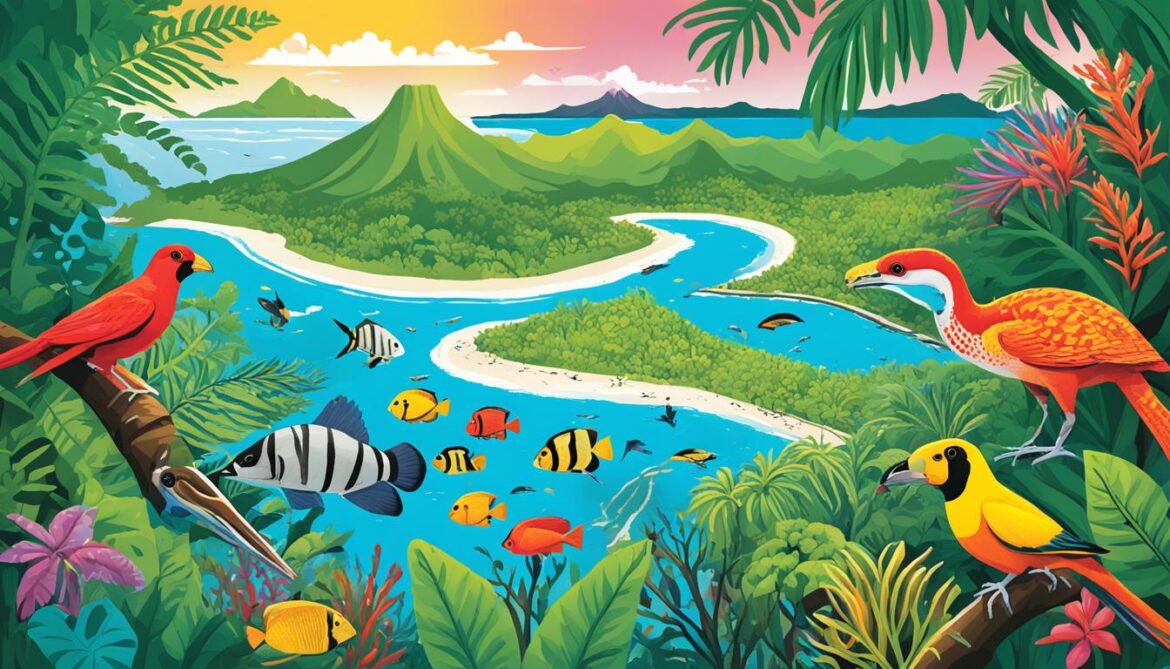
The Rich Fauna of Samoa
“Samoa’s faunal diversity is a testimony to the country’s vibrant ecosystems and the intricate web of life that exists within them. From the majestic terrestrial mammals to the colorful land birds, from the enchanting reptiles to the mesmerizing fish species, Samoa’s fauna captivates and inspires.
Protecting these diverse species is of utmost importance in maintaining the ecological balance and preserving the natural heritage of Samoa. Through conservation efforts and sustainable practices, we can safeguard this faunal diversity for future generations to cherish.”
Marine Biodiversity in Samoa
Samoa’s coastal and marine ecosystems are teeming with a diverse range of marine species, making it a haven for marine biodiversity. The country boasts a large and vulnerable reef cover that provides critical habitats for corals and other marine organisms. In fact, Samoa is home to 14 families of corals, with at least 45 identified coral species.
Despite its rich marine biodiversity, Samoa’s coastal and marine ecosystems face numerous threats. Overfishing, driven by the demand for seafood, can disrupt the balance of marine life and deplete fish populations. Coastal development, including the construction of resorts and infrastructure, can cause habitat destruction and pollution. The impacts of climate change, such as rising sea temperatures and ocean acidification, pose significant risks to the survival of corals and other marine species. These threats jeopardize the delicate balance of Samoa’s marine biodiversity.
Conservation measures are vital to protect and preserve Samoa’s marine ecosystems and the rich biodiversity they support. Efforts are being made to promote sustainable fishing practices and establish marine protected areas to safeguard critical habitats. Additionally, raising awareness about the importance of marine biodiversity and the need for its conservation is crucial for long-term sustainability.
“The health of our marine ecosystems is directly linked to the health of our planet. By protecting and preserving Samoa’s marine biodiversity, we are not only ensuring the survival of countless species but also safeguarding the delicate balance of our global ecosystem,” said Dr. Leilani Silva, marine biologist.
Threatened Coral Species in Samoa
Among the many marine species at risk in Samoa, coral reefs are particularly vulnerable. Coral reefs not only provide habitats for a wide variety of marine organisms but also offer essential ecosystem services that benefit coastal communities. However, factors such as pollution, climate change, and destructive fishing practices threaten the health and survival of coral reefs in Samoa.
Table: Threatened Coral Species in Samoa
| Coral Species |
Conservation Status |
| Acropora abrotanoides |
Endangered |
| Favites complanata |
Vulnerable |
| Porites rus |
Critically Endangered |
| Pocillopora eydouxi |
Near Threatened |
| Goniopora pedunculata |
Data Deficient |
Efforts are underway to protect these threatened coral species and restore damaged reef ecosystems. Coral reef rehabilitation projects, including coral nurseries and artificial reef structures, aim to enhance the resilience of coral populations and promote their recovery. These initiatives highlight the importance of proactive conservation measures to safeguard Samoa’s marine biodiversity.

By addressing these threats and implementing sustainable practices, Samoa can protect its marine biodiversity for future generations to enjoy.
Threats to Samoa’s Biodiversity
Samoa’s unique biodiversity is under threat from various factors. These threats include forest clearance, over-exploitation of natural resources, climate change, and invasive species. Let’s explore each of these threats in detail:
1. Forest Clearance
Forest clearance, driven by population growth and agriculture, is causing the loss and degradation of habitats in Samoa. The clearing of forests for cultivation and development disrupts the delicate balance of ecosystems, leading to the decline of species that rely on these habitats for survival.
2. Over-exploitation of Natural Resources
The over-exploitation of natural resources, such as logging and overfishing, poses a significant threat to Samoa’s biodiversity. Unsustainable practices and overharvesting can deplete populations of flora and fauna, disrupting entire ecosystems and reducing biodiversity.
3. Climate Change
Climate change and its associated impacts, such as rising sea levels and changing weather patterns, are affecting Samoa’s ecosystems. These changes can lead to habitat loss, coral bleaching, and altered ecological dynamics, threatening the survival of many species.
4. Invasive Species
Invasive species introduced to Samoa can have devastating effects on native flora and fauna. These non-native species can outcompete native species for resources or prey upon them, leading to the decline or extinction of indigenous plants and animals.
Urgent action is needed to address these threats and implement effective conservation measures. By protecting habitats, promoting sustainable resource management, and raising awareness about the importance of biodiversity, Samoa can safeguard its unique ecological heritage for future generations.
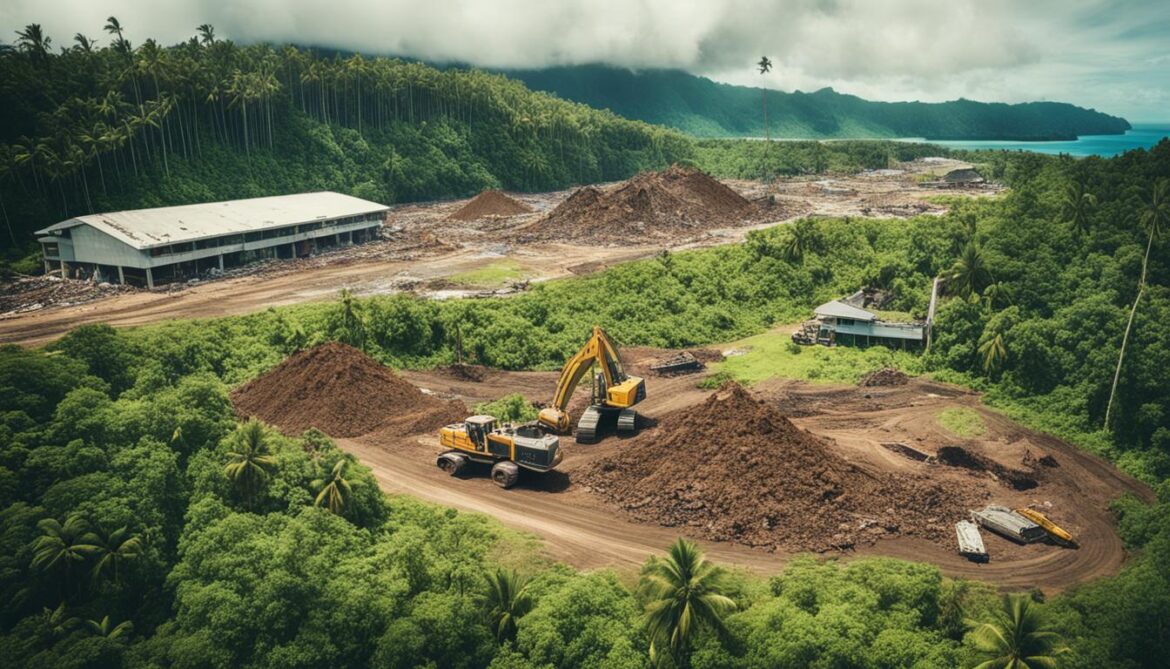
Conservation Efforts in Samoa
Samoa has taken significant steps to protect and preserve its unique biodiversity through various conservation efforts. The country has established a network of protected areas, including botanical reserves and marine protected areas, to safeguard important ecosystems and species. These protected areas serve as essential refuges for native flora and fauna, allowing them to thrive and regenerate.
Collaborative efforts between the government, local communities, and organizations play a crucial role in promoting conservation and sustainable development in Samoa. These initiatives aim to raise awareness about the importance of biodiversity conservation and encourage community involvement in conservation activities.
One of the key focuses of conservation efforts in Samoa is sustainable development. By integrating conservation principles into development planning and practices, Samoa aims to strike a balance between economic growth and environmental protection. This approach ensures that development activities are carried out in a manner that minimizes negative impacts on natural habitats and species.
Community involvement is a vital component of Samoa’s conservation efforts. Local communities play an active role in sustainable resource management, including the protection and restoration of ecosystems. They contribute traditional knowledge and practices that have been passed down through generations, enriching conservation strategies with cultural heritage.
Preserving cultural heritage is another essential aspect of conservation in Samoa. By safeguarding traditional practices, traditional knowledge systems, and sacred sites, Samoa ensures that its cultural heritage remains intact while promoting sustainable practices that contribute to biodiversity conservation.
“Conservation efforts in Samoa focus on protected areas, sustainable development, community involvement, and the preservation of cultural heritage. By working together, we can ensure the long-term protection of our biodiversity for future generations.”
To illustrate the impact of conservation efforts in Samoa, let’s take a closer look at the establishment of protected areas in the country:
| Protected Area |
Location |
Size |
Main Fauna |
Main Flora |
| Falealupo Rainforest Reserve |
Savai’i |
8,000 hectares |
Giant fruit bats, Pacific boas, tree snails |
Endemic tree species, orchids, epiphytes |
| Palolo Deep Marine Reserve |
Upolu |
5,000 hectares |
Coral reefs, sea turtles, reef fish |
Hard and soft corals, seagrass beds |
| Afu Aau Falls Wildlife Management Area |
Savai’i |
1,500 hectares |
Samoa flying fox, land birds, freshwater fish |
Endemic plant species, wetland vegetation |
These protected areas serve as critical habitats for a wide range of flora and fauna, ensuring their survival and contributing to the overall conservation of biodiversity in Samoa.
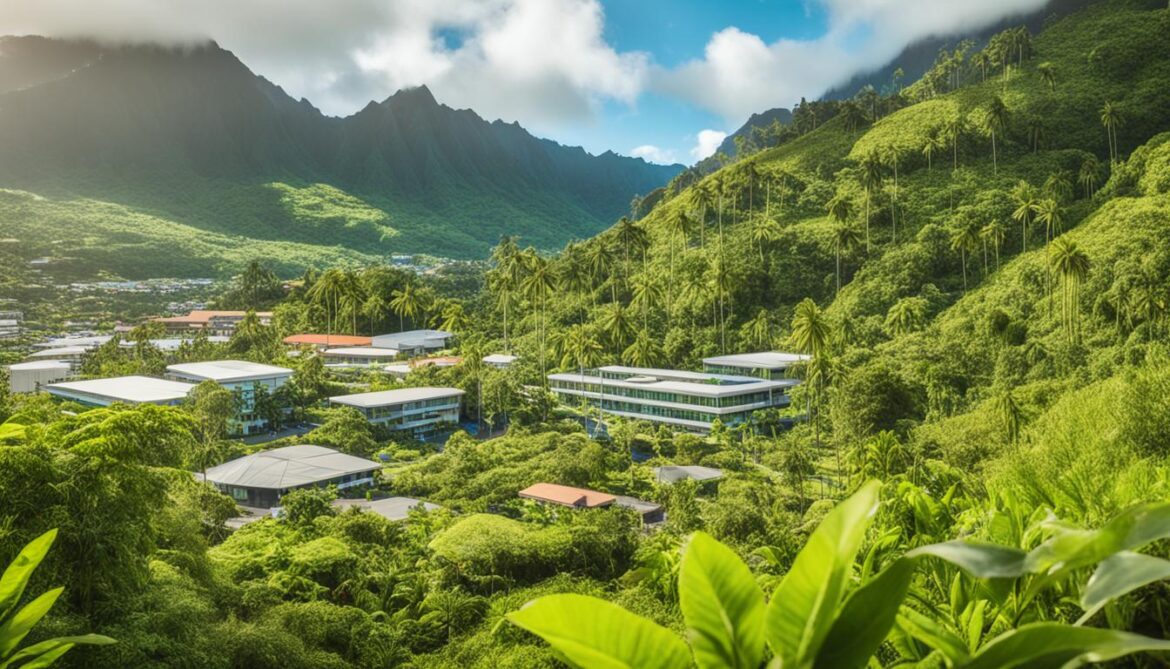
Sa’anapu Community Center: Blending Tradition and Sustainability
The Sa’anapu Community Center in Samoa is a remarkable example of sustainable design, seamlessly blending traditional Samoan architecture with modern features. This project showcases the synergy between tradition and sustainability, demonstrating how indigenous building practices can be integrated with modern technologies.
The center incorporates sustainable elements such as solar energy systems and water tanks to minimize its carbon footprint and ensure a stable water supply. By harnessing solar energy, the center reduces its dependency on non-renewable energy sources and lowers its environmental impact.
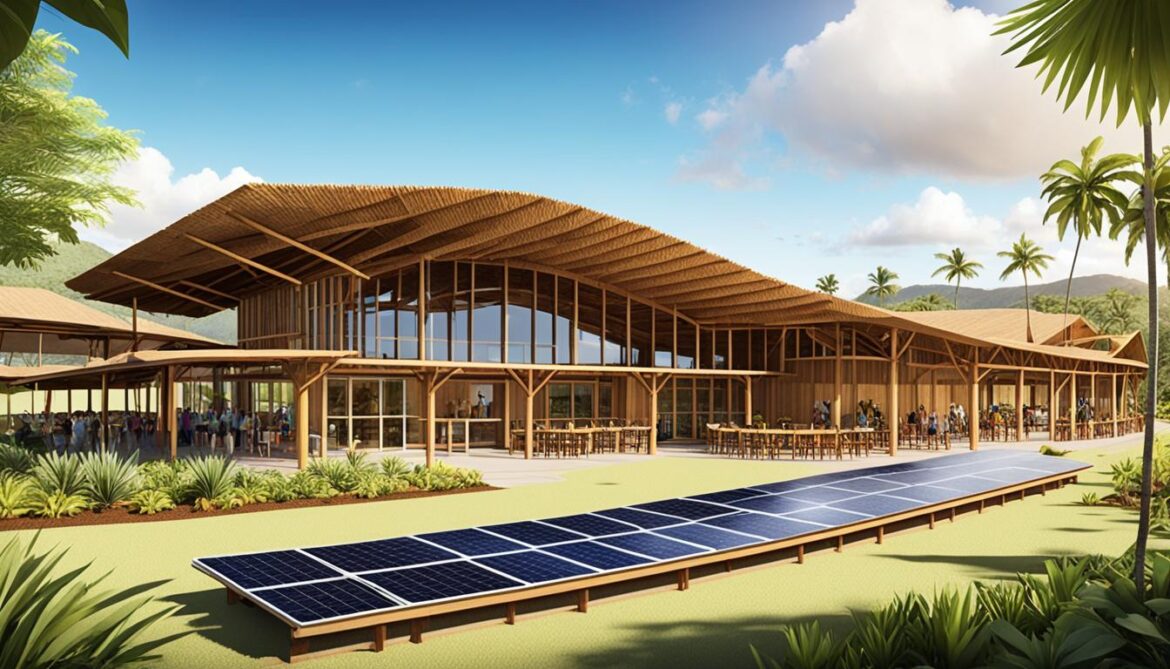
The integration of water tanks allows for efficient collection and storage of rainwater, enabling the community center to meet its water needs while reducing dependence on external water sources. This sustainable water management system contributes to water conservation in the region.
In addition to sustainable infrastructure, the center’s design incorporates disaster resilience. With the capacity to shelter people during emergencies, the Sa’anapu Community Center provides a safe haven for the community in times of crisis.
The Sa’anapu Community Center stands as a testament to the importance of sustainable design in preserving cultural heritage and fostering a harmonious coexistence between humans and the environment.
The Benefits of Traditional Samoan Architecture
Traditional Samoan architecture showcases numerous advantages in terms of sustainability, climate adaptation, and social cohesion. The open structure of the fale, a traditional Samoan house, facilitates natural ventilation, helping to regulate temperature and reduce the risk of damage during cyclones. The use of a lashing technique in construction provides flexibility and strength, making the buildings more resilient to extreme weather events. By embracing these traditional building practices, Samoa not only preserves its cultural heritage but also enhances the resilience and sustainability of its communities.
The open design of the fale allows for optimal airflow, ensuring comfortable living conditions in Samoa’s tropical climate. With fewer enclosed spaces, it minimizes the need for artificial cooling systems, leading to energy savings.
“The open structure of the traditional fale promotes natural ventilation and reduces the risk of damage during cyclones.”
The lashing technique, involving the use of natural materials like coconut fibers, contributes to the adaptability of traditional Samoan architecture. This construction method allows buildings to withstand high winds and remain intact, making them more resistant to cyclones, a prevalent natural hazard in the region.
Moreover, traditional Samoan architecture fosters social cohesion and effective governance within the community. The construction process of these buildings often involves the collective effort of family members, reinforcing bonds and promoting collaboration. The shared spaces created by the architecture encourage social activities and interactions, enhancing a sense of community and cultural identity.
Overall, traditional Samoan architecture not only showcases the creativity and craftsmanship of the Samoan people but also provides practical solutions for sustainable living.
The fusion of traditional building practices with modern technologies can further enhance the sustainability and resilience of these structures. Implementing solar energy systems and rainwater harvesting techniques, for example, can increase self-sufficiency, reduce carbon footprints, and alleviate strain on local resources.
By embracing and preserving traditional Samoan architecture, Samoa demonstrates its commitment to sustainability, climate adaptation, and the preservation of its cultural heritage.
Advantages of Traditional Samoan Architecture:
| Advantages |
Description |
| Natural Ventilation |
The open structure of the fale promotes natural airflow, reducing the need for artificial cooling systems and saving energy. |
| Resilience to Cyclones |
The lashing technique used in construction provides flexibility and strength, making the buildings more resistant to extreme weather events like cyclones. |
| Social Cohesion |
The communal nature of traditional Samoan architecture fosters social interactions and effective governance within the community. |
| Sustainability |
The fusion of traditional building practices with modern technologies can enhance the sustainability and resilience of these structures. |
Challenges of Western-style Buildings in Samoa
Western-style buildings in Samoa face unique challenges in terms of their vulnerability to cyclones and severe weather events. The vertical rigid walls of these buildings make them more susceptible to wind damage compared to traditional Samoan fale structures. The open design of the fale allows for the passage of strong winds, reducing the likelihood of structural damage. Additionally, Western-style buildings often rely on multiple points of connection in their construction, which increases their vulnerability.
Samoa recognizes these challenges and emphasizes the importance of sustainable and resilient building techniques. By integrating traditional Samoan construction techniques with modern materials and technologies, the country aims to enhance the structural integrity of buildings while minimizing their impact on the environment.
“The vulnerability of Western-style buildings in Samoa highlights the need for sustainable and resilient construction practices. By embracing the lessons from traditional Samoan architecture, we can enhance the resilience of our built environment and protect our communities from the impacts of cyclones and severe weather events.” – Samoan Ministry of Infrastructure
In order to promote resilient building practices, Samoa encourages the use of construction techniques that prioritize:
- Structural flexibility: The ability of buildings to withstand strong winds and movement without suffering significant damage.
- Disaster-resistant materials: The use of materials that can withstand the forces of cyclones and severe weather events, minimizing the risk of structural failure.
- Proper foundations: Ensuring that buildings are securely anchored to the ground, reducing the risk of structural collapse during high winds.
- Efficient drainage systems: Designing effective drainage systems to prevent flooding and water damage, which can weaken the structural integrity of buildings.
By adopting these construction practices, Samoa aims to enhance the resilience of its built environment and ensure the safety of its residents during times of natural disaster.
Comparison of Western-style Buildings and Traditional Samoan Fale Structures
| Aspects |
Western-style Buildings |
Traditional Samoan Fale Structures |
| Design |
Vertical rigid walls |
Open design with thatched roofing |
| Resilience to Cyclones |
Less resilient due to vertical walls and multiple points of connection |
More resilient due to open design and flexible materials |
| Structural Integrity |
Reliant on rigid materials and complex construction techniques |
Reliant on flexible materials and traditional lashing techniques |
| Sustainability |
Varies depending on construction materials and techniques |
Built using renewable natural materials |
By considering the vulnerabilities of Western-style buildings and embracing resilient construction techniques, Samoa aims to create a built environment that can effectively withstand the impacts of cyclones and severe weather events, ensuring the safety and well-being of its communities.
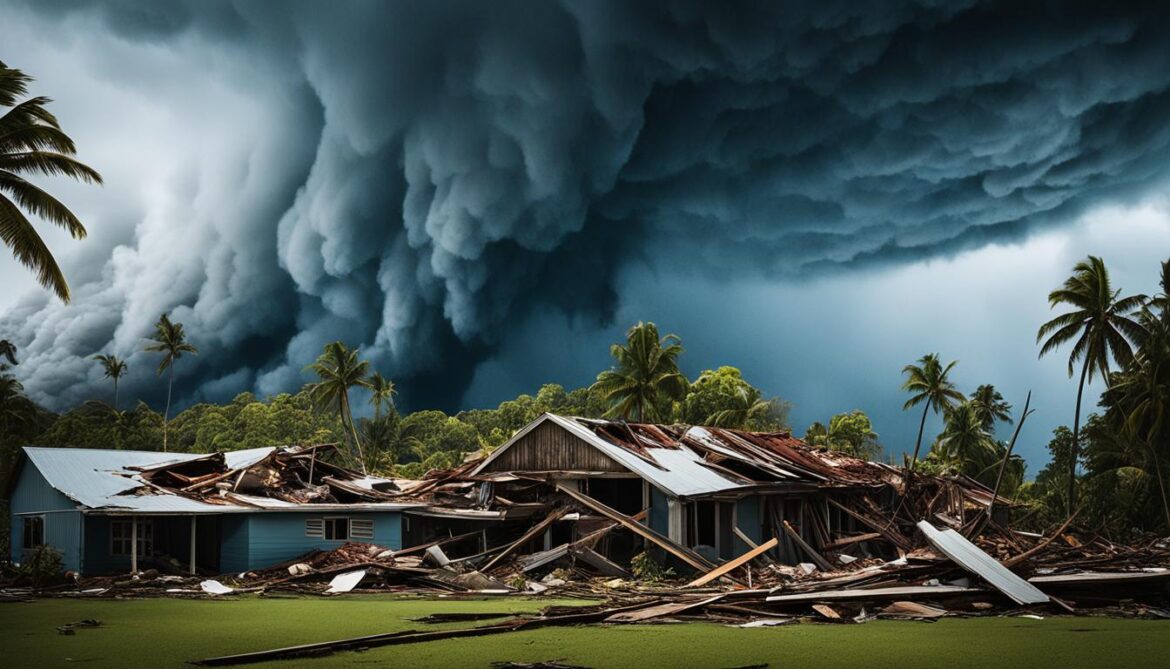
Sustainable Accommodation in Samoa: Exploring Eco-Friendly Stays
When visiting Samoa, travelers have the opportunity to choose sustainable accommodation options that minimize environmental impact and promote conservation of natural resources. Eco-friendly stays prioritize renewable energy sources and support local communities. One unique accommodation option in Samoa is the fale, a traditional wooden bungalow that immerses guests in the natural beauty of the island. Sustainable accommodation choices minimize environmental impact, support local economies, and offer an authentic experience for travelers.
The Fale: A Sustainable Retreat
The fale is a quintessential example of sustainable accommodation in Samoa. These traditional wooden bungalows are designed to blend harmoniously with the surrounding environment, utilizing locally sourced materials and traditional building techniques. The open-air structure allows for natural ventilation, reducing the need for air conditioning and minimizing energy consumption.
The fale also embraces renewable energy sources. Many accommodations now incorporate solar energy systems, providing a clean and sustainable power supply. This not only reduces reliance on fossil fuels but also lowers carbon emissions, contributing to a greener and more sustainable future.
Furthermore, staying in a fale supports the local communities in Samoa. Many accommodations are run by local families or communities, which ensures that the economic benefits of tourism remain within the region. By choosing sustainable accommodation, travelers are actively participating in the preservation of local culture and supporting the livelihoods of the Samoan people.
“Choosing sustainable accommodation allows travelers to enjoy the beauty of Samoa while minimizing their environmental impact and making a positive contribution to the local communities.”
The Benefits of Eco-Friendly Stays
Opting for eco-friendly stays in Samoa not only benefits the environment but also enhances the overall travel experience. By immersing oneself in a sustainable retreat, travelers have the opportunity to reconnect with nature and appreciate the beauty of Samoa’s diverse ecosystems.
Moreover, sustainable accommodation options often offer unique activities and experiences that provide insights into the local culture and traditions. Guests can participate in traditional crafts, learn about organic farming practices, or engage in community-led conservation initiatives. These immersive experiences foster a deeper appreciation for the environment and promote cross-cultural understanding.
By supporting eco-friendly stays in Samoa, travelers play an active role in preserving the natural beauty of the islands for future generations. Together, we can make a difference in creating a more sustainable and responsible tourism industry.
Comparison of Sustainable Accommodation Options in Samoa
| Accommodation |
Renewable Energy |
Local Community Support |
Price Range |
| Traditional Fale |
Yes (Solar energy) |
Run by local families/communities |
$$ |
| Eco-Lodge |
Yes (Solar/wind power) |
Supports local community projects |
$$$ |
| Resort with Sustainability Initiatives |
Varies (Solar/wind power initiatives) |
Contributes to local conservation efforts |
$$$$ |
Note: Prices are approximate and may vary depending on the specific accommodation and seasonal factors.

Whether it’s staying in a traditional fale, an eco-lodge, or a resort with sustainability initiatives, choosing sustainable accommodation in Samoa allows travelers to enjoy the beauty of the islands while minimizing their environmental impact. These eco-friendly stays prioritize renewable energy and support local communities, offering a unique and authentic experience. Together, we can contribute to the preservation of Samoa’s natural resources and help create a sustainable future for all.
Conclusion
Samoa Biodiversity and the Built Environment are inseparably linked, as the conservation of diverse plant and animal species depends on sustainable strategies. However, Samoa’s delicate ecosystems face numerous threats, including habitat loss, over-exploitation of natural resources, climate change, and invasive species. To protect its unique biodiversity and ensure a sustainable future, Samoa must prioritize conservation efforts.
Conservation efforts in Samoa encompass various strategies, such as establishing protected areas, promoting sustainable architecture, engaging local communities, and preserving cultural heritage. These initiatives aim to safeguard vital habitats, enhance biodiversity management, and foster the coexistence of nature and development.
By valuing and investing in the conservation of Samoa’s biodiversity and the built environment, the country can combat the challenges posed by human activities and climate change. Through collaborative efforts, sustainable development practices, and community involvement, Samoa can lay the foundation for a thriving future where both nature and people flourish.
FAQ
How diverse is Samoa’s flora?
Samoa’s flora is incredibly diverse, with 500 species of native flowering plants and 220 species of ferns. Approximately 25% of the native plant species in Samoa are endemic, contributing to its unique biodiversity.
What are the different plant communities in Samoa?
Samoa’s vegetation is classified into five plant communities, each supporting a variety of plant species adapted to Samoa’s climate and terrain.
What is the significance of fern species in Samoa?
The fern species in Samoa enhance the beauty of the forests and wetland areas.
What faunal species can be found in Samoa?
Samoa is home to a rich variety of fauna, including terrestrial mammals, land birds, seabirds, reptiles, insects, land snails, and fish species.
How many fish species have been recorded in Samoa?
The fish fauna in Samoa is particularly diverse, with up to 991 species recorded.
What threats does Samoa’s marine biodiversity face?
Marine biodiversity in Samoa is facing significant threats due to overfishing, coastal development, and the impacts of climate change.
What are the major threats to Samoa’s biodiversity?
The major threats to Samoa’s biodiversity include forest clearance, over-exploitation of natural resources, climate change, and invasive species.
What conservation measures are in place in Samoa?
Samoa has established protected areas, including botanical reserves and marine protected areas, to safeguard important ecosystems and species. Collaborative efforts between the government, local communities, and organizations aim to promote sustainable development practices and raise awareness about biodiversity conservation.
How does traditional Samoan architecture contribute to sustainability?
Traditional Samoan architecture offers several benefits in terms of sustainability and climate adaptation. The open structure of the fale promotes natural ventilation and reduces the risk of damage during cyclones. The lashing technique used in construction provides flexibility and strength, making the buildings more resistant to extreme weather events.
What are the challenges faced by Western-style buildings in Samoa?
Western-style buildings in Samoa face challenges when it comes to their vulnerability to cyclones and severe weather events due to their vertical rigid walls and multiple points of connection in their construction.
What are some sustainable accommodation options in Samoa?
When visiting Samoa, travelers have the opportunity to choose sustainable accommodation options that minimize environmental impact and promote conservation of natural resources. Eco-friendly stays prioritize renewable energy sources and support local communities. One unique accommodation option in Samoa is the fale, a traditional wooden bungalow that immerses guests in the natural beauty of the island.
Source Links






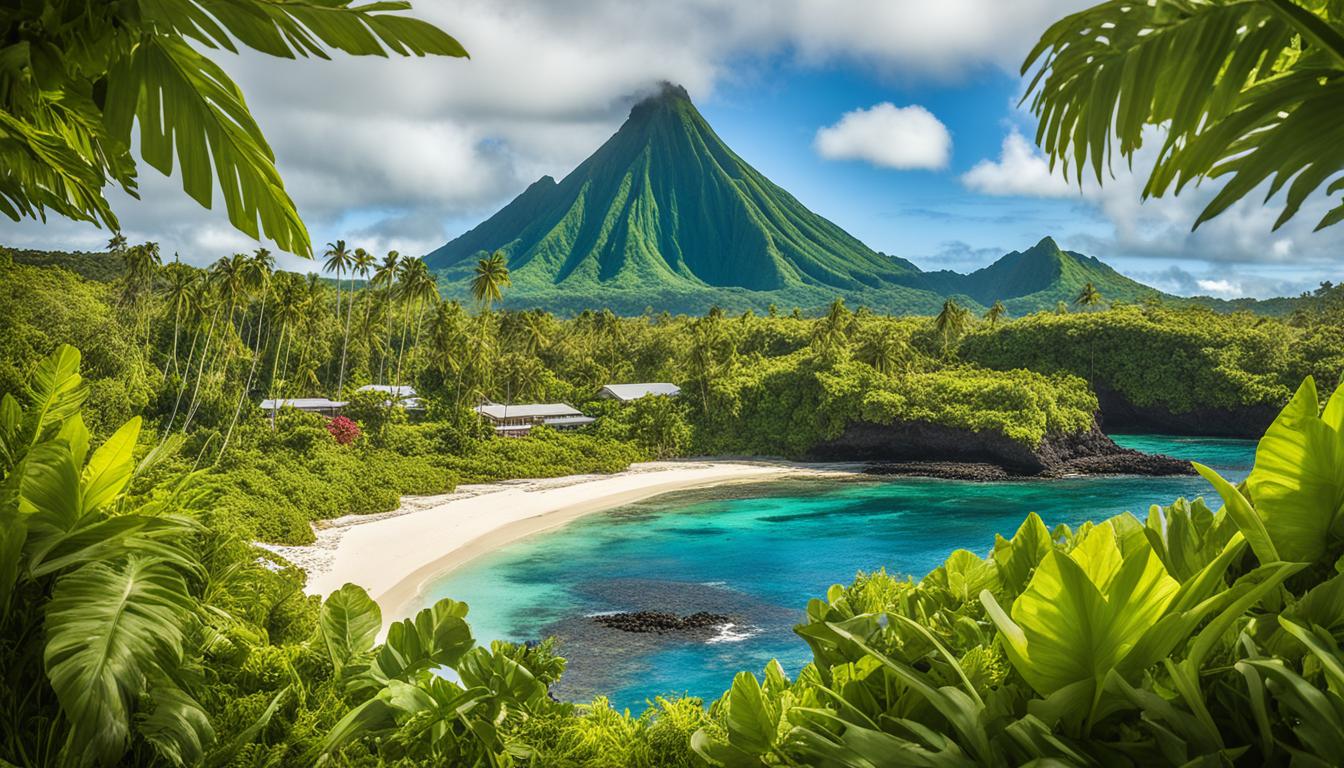


















Post comments (0)